Designer handbags didn’t just pop up overnight; they have a rich history that's fascinating. The journey started way back in the early 1900s when fashion was all about elegance and craftsmanship. Think of iconic brands like Louis Vuitton and Gucci sprouting from that era.
In the 1920s, the handbag really started to evolve. Women wanted to express not just style but individuality. Designers began making bags that were as much about the look as they were about function. Coco Chanel emerged as a pioneer, introducing the famous Chanel 2.55 bag that changed the game. It wasn’t just a handbag; it was a statement piece.
Fast forward to the 1960s and 70s, and we see designer bags becoming a status symbol. Celebrities flaunted these bags, and suddenly, everyone wanted one. This was the time when brands began creating limited editions and unique designs, making each handbag feel super special. Owning a designer handbag wasn’t just about having a bag—it was about being part of a lifestyle.
Today, designer handbags have truly become a fashion staple. With various styles, colors, and brands available, there’s something for everyone. Whether it’s a trendy crossbody or a classic tote, these bags let you showcase your personality while keeping it chic. They’re not just functional; they tell a story and make a statement. Isn’t that what fashion is all about?
Iconic Moments in Handbag History
Handbags have a rich history that’s steeped in style and innovation. One of the most iconic moments came in the 1930s with the introduction of the Kelly bag by Hermès. Originally designed as a saddle bag, it quickly transformed into a must-have fashion statement after Grace Kelly famously used it to shield her baby bump from the paparazzi. Suddenly, everyone wanted to carry the same elegance she did.
Fast forward to the 1950s, when Chanel launched the 2.55 bag. With its quilted design and chain strap, this beauty revolutionized how women thought about handbags. No longer just functional, these bags became a core part of personal style. Today, the 2.55 remains a timeless classic that every fashion lover knows.
The '90s brought us the iconic Gucci Bamboo bag, which showcased a striking blend of fashion and function. With its unique bamboo handle, this bag wasn't just a trend; it marked a shift toward a more artistic approach in handbag design. Celebrities like Madonna and Jennifer Aniston flaunted it, setting the stage for bags as art pieces.
In the 2000s, we saw the birth of the Louis Vuitton Neverfull tote. This bag embraced versatility and practicality, catering to modern women on the go. Its sleek design and spacious interior make it a staple for anyone who needs style without sacrificing function. The Neverfull continues to fly off the shelves, proving its timeless appeal.
Famous Brands and Their Signatures
When you think about luxury handbags, certain brands instantly come to mind. Each of these famous names has a unique style that sets them apart. Let’s dive into what makes these bags so special.
Chanel is iconic for its timeless designs and classic elegance. The Chanel 2.55, with its distinctive quilted leather and signature chain strap, is a staple in every fashionista's closet. It's not just a bag; it's a piece of history that carries a rich story behind it.
Then there’s Louis Vuitton, known for its monogram canvas and signature check patterns. The Speedy bag is a must-have for anyone who loves a blend of practicality and style. This bag screams luxury while making it easy to carry all your essentials—perfect for a busy day out.
Gucci has carved its niche with bold designs and a flair for the dramatic. The GG Marmont line, with its unique chevron pattern and chunky chain, is a favorite among trendsetters. It’s perfect if you want to make a statement and stand out in the crowd.
Last but not least, we can’t forget about Prada. The Nylon Backpack took the fashion world by storm with its sleek, modern look. It combines style and function effortlessly, making it a go-to for anyone seeking a chic yet practical option.
Trends That Shaped the Handbag Industry
Handbags have come a long way, evolving through various trends that really shaped the way we see them today. In the early days, form was key, often prioritizing functionality over flair. Fast forward to the 20th century, and we start to see luxury brands like Louis Vuitton and Chanel making bags not only practical but also totally fashionable. They set a standard, showing that handbags could be a statement piece rather than just an accessory.
In the '80s and '90s, designer branding exploded. People wanted bags that flaunted their social status, and labels like Gucci and Prada delivered just that. Iconic styles, like the LV Speedy or the Chanel Flap Bag, became must-haves, with celebrities and influencers rocking them everywhere. The idea of carrying a designer handbag became essential for those looking to make a mark.
As we moved into the 2000s, the rise of the internet changed the game. Online shopping made luxury handbags more accessible, while social media allowed trends to spread quicker than ever. Suddenly, everyone wanted the latest “It” bag, leading to the rise of limited-edition releases that created buzz and hype. Brands like Balenciaga and Off-White jumped on this trend, introducing bold, fresh designs that challenged traditional ideas of luxury.
Today, sustainability is at the forefront. Consumers are more mindful than ever about where their products come from. Brands are starting to respond, finding ways to make bags from eco-friendly materials or even revamping pre-loved pieces. It’s a win-win: you can treat yourself to a stunning bag while also supporting a better planet. The evolution of handbags shows how style and values can go hand in hand.



